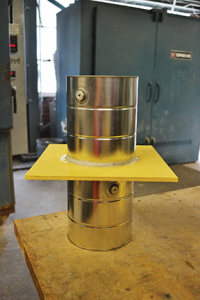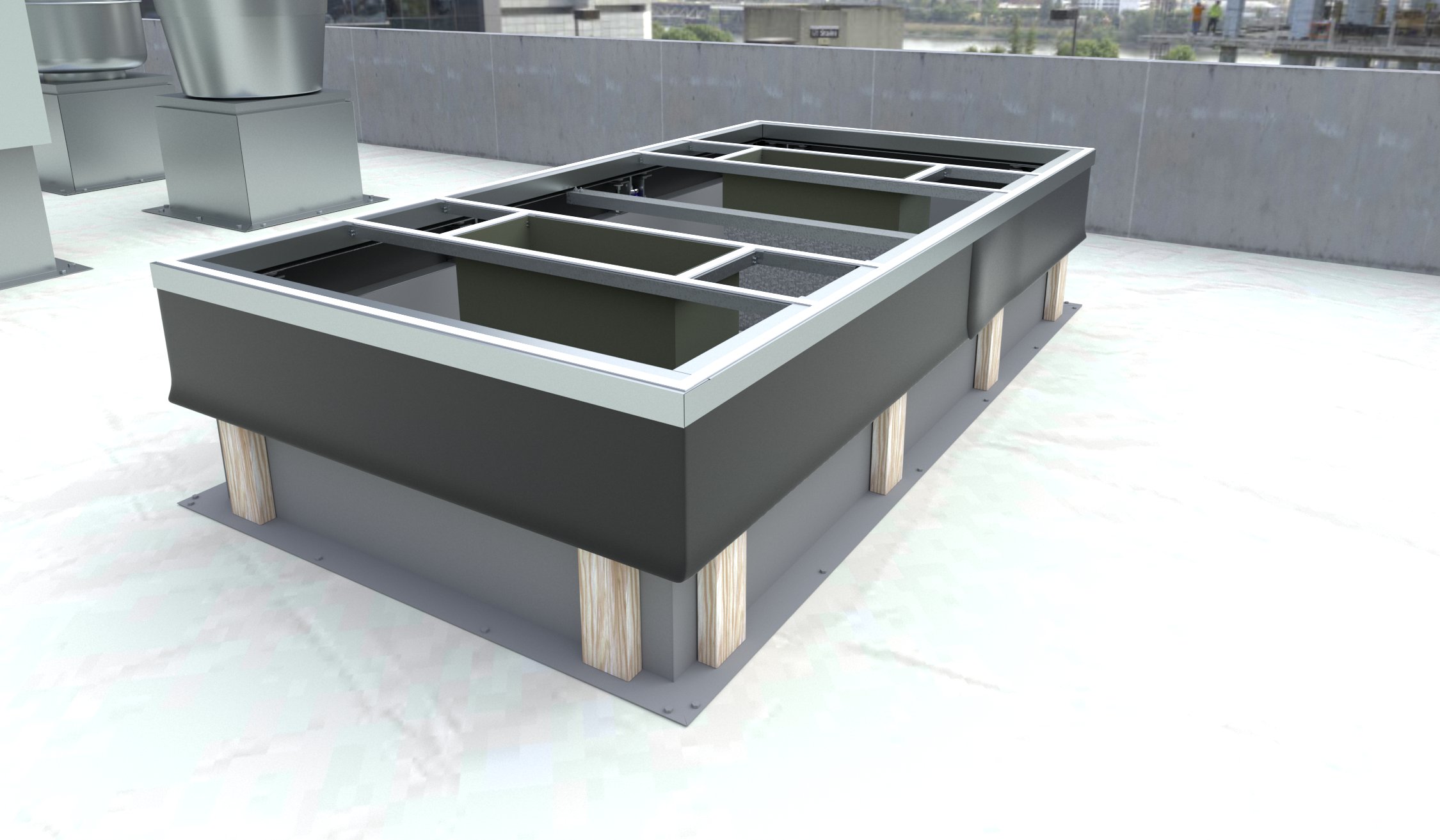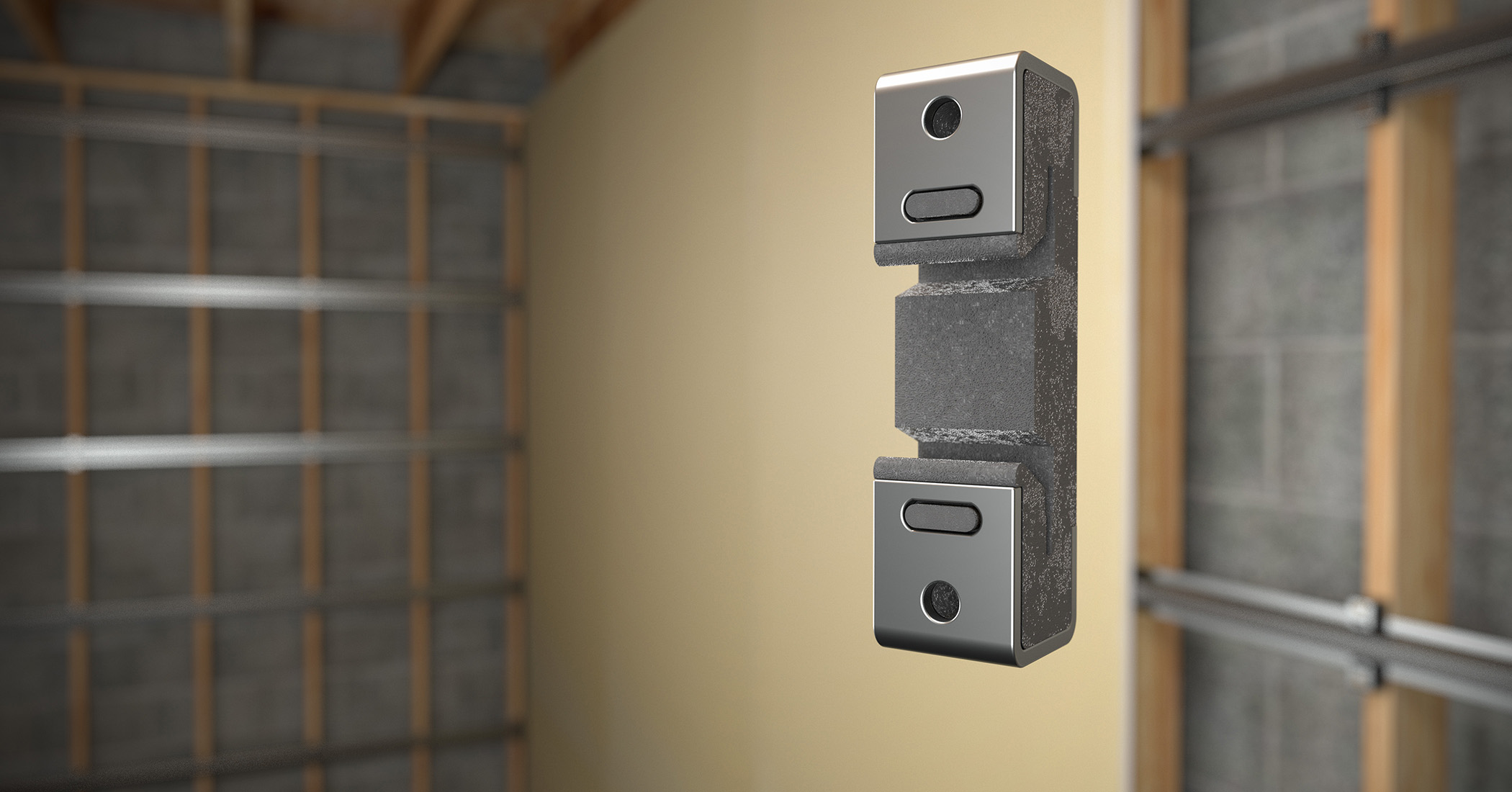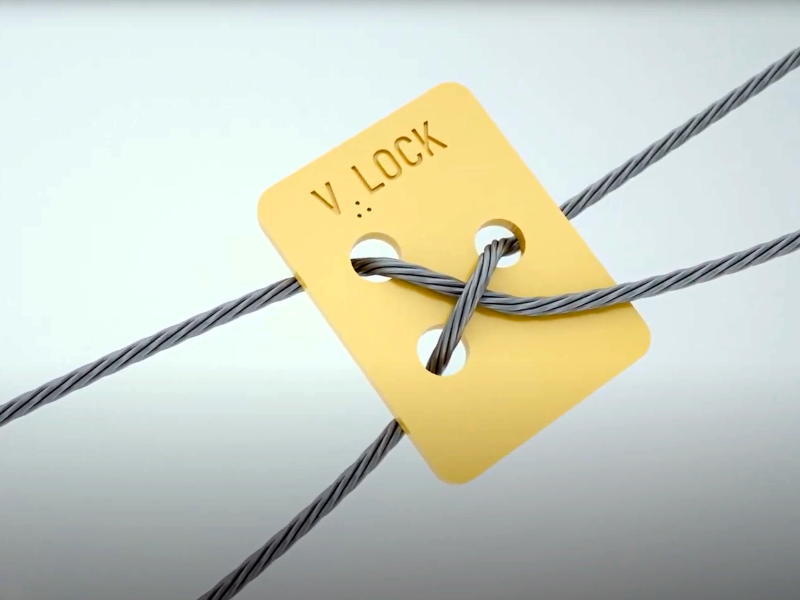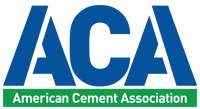Durability of water-resistive barriers
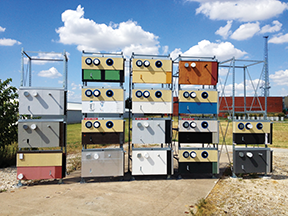
by Beth Anne Feero, EIT and David H. Nicastro, PE
Many new water-resistive barrier (WRB) products are being introduced, including liquid-applied membranes. These new products join traditional wraps, self-adhered membranes, felts, and building paper, making for a crowded marketplace. A WRB will be concealed behind cladding, where it cannot be inspected, maintained, or replaced, so it must last for the design life of the building. However, will the new products be durable?
WRBs are required by building codes, and are installed on nearly every building, so it is surprising the industry lacks standardized tests for many fundamental properties of WRB products. To evaluate their performance, 17 WRB products (new and old) were tested in various common construction details, along with accessory products (flashings, tapes, and sealants). This long-term study is ongoing, but has already yielded important observations.
Product selection
As its name implies, the purpose of a WRB is to stop liquid water from penetrating through a wall section. However, more products are sold as air barriers, with a corollary benefit of serving as a WRB—and, in some cases, as a vapor barrier. The products included in this study were confirmed with the manufacturers to function as WRBs, but their marketing literature does not always make that clear. As this industry is rapidly evolving, there is some confusion as to the terminology and functions of these products (Figure 1).
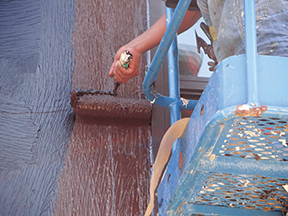
The 2012 International Building Code (IBC) states that in typical sheathing applications, “a minimum of one layer of No. 15 asphalt felt, complying with ASTM D226, Standard Specification for Asphalt-saturated Organic Felt Used in Roofing and Waterproofing, for Type 1 felt or other approved materials, shall be attached to the studs or sheathing.” A similar statement is found in the International Residential Code (IRC). For stucco and masonry veneer applications, both codes require wood-based sheathing “include a water-resistive vapor-permeable barrier with a performance at least equivalent to two layers of Grade D paper.”
Many buildings are still being constructed with felt or building paper serving as the WRB. However, the industry is shifting toward products that can also serve as an air barrier—sometimes called ‘weather-resistive barriers.’ For their WRB function, these products have to be approved by building officials based on test reports demonstrating they perform as well as paper or felt. This does not seem like a very high bar, but it could be if durability were considered instead of just initial test results (Figure 2).
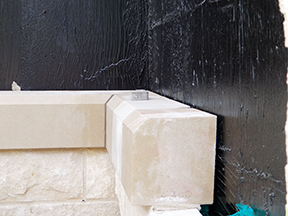
Even if they provide only marginal waterproofing, paper and felt have been in service for decades, so their long-term behavior is well-established. By comparison, a few of the new WRBs have suffered various forms of product failure soon after application, resulting in manufacturers revising the formulations or application instructions (Figure 3).
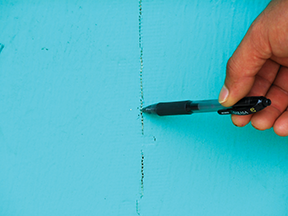
For this study, products were selected based on criteria that would be considered by designers and contractors for a multi-family building—one of the largest segments of the construction industry. (Most of these products would also be appropriate for large commercial projects, as well.) Research narrowed the products to those believed likely to continue to be sold in their present formulation—since some test results will not be attainable for several years, it would be pointless to invest in long-term testing of products that seemed questionable during the research phase. Additionally, products with a short allowable exposure time before cladding were eliminated because newer materials are being introduced with longer exposure time. As research indicates other viable products, they will be tested in the future.
Interpreting manufacturer’s instructions
Field investigations suggest most failures are caused by ‘what is on the outside of the can’—in other words, even the best products fail prematurely when the installation instructions are not clear (or followed). Sufficient information from the manufacturer is needed for correct use, including which accessory products are required and appropriate design details for typical penetrations, edges, and openings. Providing explicit, concise, and comprehensive instructions for the designer and installer is essential, but rare.
Before the test specimens were constructed, extensive time was spent researching the manufacturers’ publications. Some of the conditions being tested were not found in the instructions and details. For other products, there were multiple accessory choices that were not clearly defined, leading to possible wrong selections. For most of the products studied, it was necessary to contact the manufacturer to confirm the selections; in some cases, the technical support representatives contradicted the published information (and each other when both local and home-office personnel were contacted). While it is always a good design practice to involve the manufacturer, it would be better for the industry if these common details were clearly conveyed.
Another problem is some of the instructions provided are unrealistic. For example, several of the selected products require special detailing around brick ties, which is not economically viable (Figure 4). Voiding a manufacturer’s warranty is less of a concern than the potential for failures in systems that cannot self-seal such fastener penetrations.
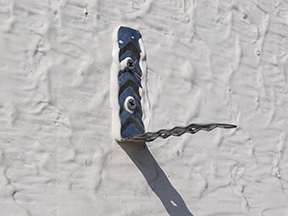
Ease of installation
Installers want WRB products that are easy and fast to install—to be economical, they want to avoid mixing multiple components, long drying times, multiple accessories, or fussy sequencing requirements. Keeping systems to the fewest products (such as a primary membrane for the field of the wall and a single accessory for detailing) reduces installation time and the possibility of errors.
The test products were installed by a specialty contractor, whose observations and comments indicated there was a wide range of difficulty in applying the products.
UV exposure rating
There are several new WRB products that are not sensitive to ultraviolet (UV) light, which would therefore make them good candidates to be used behind rainscreen cladding. These sophisticated, engineered cladding systems feature pressure-equalized compartments behind a veneer with permanently open joints, so it is important sunlight not damage the membrane through the joints.
For more common cladding systems, it is important to pay attention to the manufacturer’s published maximum exposure time for WRBs before they are covered with cladding. Interestingly, they each publish a single time limit (typically one to 12 months), but obviously the actual exposure during that period would vary depending on the climate and season. Therefore, the risk of prolonged exposure is uncertain.
Overall, the mockup specimens appear to be performing well, but some damage was already observed before reaching the claimed exposure limit. Most of the test specimens were first exposed in the winter; it can be expected the damage due to UV exposure would be worse if the testing started in the summer.
Contractors want longer exposure time, and the newest products being introduced claim to have this capability. This trend may tempt manufacturers into a marketing ‘arms race’ of sorts. During this research, some manufacturers changed their exposure rating without changing the formulation. The testing described below was designed to evaluate both the current exposure ratings and any increased timeframes claimed in the future. Although longer exposure time benefits the contractor, it is not clear benefit accrues to the owner.
Fire resistance
Performing fire testing is beyond the study’s scope, but the manufacturers’ literature typically addresses this requirement. With recent changes in code requirements (and more expected with the next IBC), water-resistive barriers are now being scrutinized for fire resistance in wall assemblies.
WRBs that are combustible and placed on a building over 12.2 m (40 ft) tall having a Type I?IV construction must be tested in an assembly that passes National Fire Protection Agency (NFPA) 285, Standard Method of Test for the Evaluation of Flammability Characteristics of Exterior Non-load-bearing Wall Assemblies Containing Combustible Components. A recent trend appears to be WRB manufacturers partnering with various other component manufacturers (including insulation, masonry anchors, and cladding) to create complete wall assemblies meeting this requirement.
Mockup test design
In the first phase of this study, WRB products were tested as part of a complete system. The research outlined above guided the design of mockup test specimens that represent most of the difficult details encountered on a typical project. Each specimen consists of a 0.9 x 0.6-m (3 x 2-ft) simulated wood stud wall segment with the WRB placed on plywood sheathing (except one product with an integral sheathing).
Each specimen contained multiple details a WRB system must be able to handle, as shown in Figure 5:
- ?sheathing joint at the center (3.2-mm [1?8-in.] gap);
- ?outside corner at the bottom and left edge;
- window jamb flange at the right edge;
- octagonal electrical junction box penetration;
- large-diameter penetration (e.g. dryer vent);
- small-diameter penetration (e.g. plumbing pipe); and
- masonry veneer anchor (i.e. brick tie).
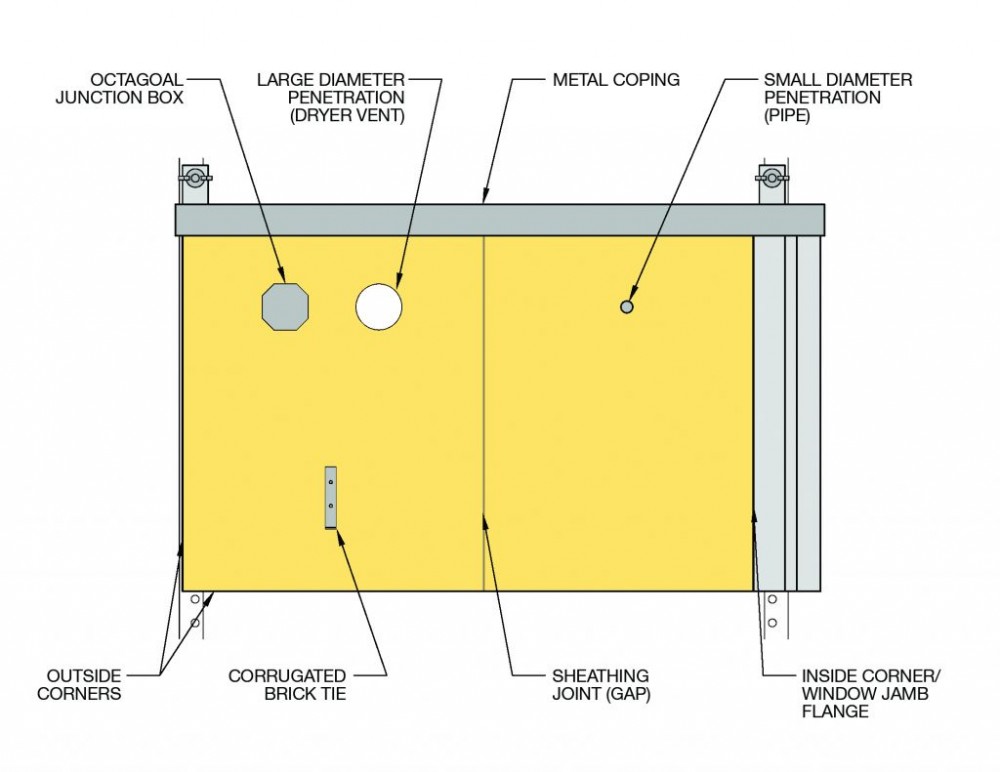
The details were sealed as required by each manufacturer—not based on what is commonly done in the field (Figure 6). While some of those requirements seem burdensome, the initial testing is intended to evaluate the system as recommended by the manufacturer.
The specimens were hung on metal racks facing solar south to be subjected to high solar radiation (in addition to wind and rain). They were placed vertically to simulate typical wall construction. Laying them back at an angle would have increased solar radiation to significantly accelerate the weathering, but it would eliminate another significant factor in performance: gravity. WRB products are often observed in the field to sag after exposure, which tugs on the flashings (Figure 7).
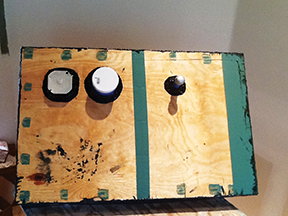
Once the specimens are exposed for their documented UV exposure rating, they are partially covered with a cement board to represent siding. This cladding is attached with screws, which tests additional fastener penetrations while also allowing the siding to be removed for observations. Only the top half of each specimen is covered; the bottom remains exposed to observe how the products deteriorate after the specified exposure time.
Clear rigid plastic was installed over the back of the specimens to prevent direct water entry, while allowing monitoring of any moisture penetration or damage from the front (product side). A metal coping protects the top of each specimen, but it is not sealed to the cladding—water can enter above the cladding so the WRB will be wetted by rain even after the cladding is applied (the essence of a WRB).
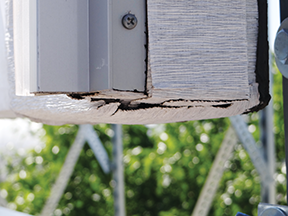
Besides the large mockup specimens, additional small ones are being tested for material properties, including adhesion, that are beyond this article’s scope. Other small specimens are used for the nail sealability testing described below.
Conclusion
Improving durability requires addressing long-term behavior, which is typically related to weathering and chemical formulation. These aspects of a product’s ‘design life’ will be evaluated during the long-term testing described above; a future article will summarize those findings after sufficient exposure. Some premature failure has already been observed, which indicates the need to be vigilant in product selection regarding claimed exposure ratings.
The research and mockup testing also were designed to evaluate a product’s ‘service life,’ which is often governed by the original installation. The results so far indicate the industry needs better information, instructions, and details from manufacturers. To be economical and durable, an ideal WRB system would include only a few required products that are easy to install, cure rapidly, adhere well, seal around fastener holes, and withstand UV exposure for an extended time. None of the products tested so far met all of these criteria.
The industry also needs standard test methods and product specifications that are applicable to WRBs (and air barriers). Some of these are in development by professional societies, but those will take time to develop. Meanwhile, specifiers should be aware the tests cited by manufacturers may not be applicable to the performance criteria needed for a WRB. Most notably, a product’s claimed ability to seal around fasteners should be scrutinized—this study revealed the test methods and published information are generally unreliable regarding this fundamental property of WRBs.
Note: The authors gratefully acknowledge the continuing support and leadership of David W. Fowler, PhD, PE—the faculty advisor for the research being performed at The Durability Lab, a testing center at The University of Texas at Austin.
Beth Anne Feero, EIT, is a graduate student studying architectural engineering at the University of Texas at Austin. She serves as the graduate research assistant for The Durability Lab, which researches and tests the durability of building components, identifying factors causing premature failure. She can be reached via e-mail at bfeero@buildingdx.com.
David H. Nicastro, PE, is the founder of Building Diagnostics Inc., specializing in the investigation of problems with existing buildings, designing remedies for those problems, and resolving disputes which arise from them. He is a licensed professional engineer, and leads the research being performed at The Durability Lab—a testing center established by Building Diagnostics at the University of Texas at Austin (UT). He can be reached by e-mail at dnicastro@buildingdx.com.

